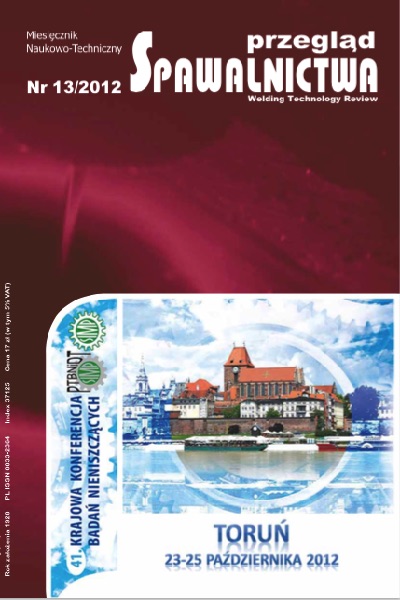Diagnozowanie konstrukcji lotniczych metodą prądów wirowych i metody modelowania sygnałów elektromagnetycznych
Main Article Content
Abstract
Przedmiotem artykułu jest opracowanie nowych procedur wykrywania uszkodzeń w konstrukcjach lotniczych. Klasyczne podejście jest oparte na optymalizacji parametrów badania takich jak: częstotliwość oraz rozmiar i typ sondy. Jednakże wykrycie i charakterystyka występujących uszkodzeń jest trudne chociażby ze względu na budowę badanej struktury (np. występowanie rożnego rodzaju wzmocnień), czy też na istnienie całej gamy różnych uszkodzeń (może występować np. korozja w połączeniach międzywarstwowych, korozja ukryta, pęknięcia zmęczeniowe itp.). Dlatego postanowiono opracować metodę badawczą, usprawniającą proces diagnostyczny, opartą na połączeniu metody eksperymentalnej prądów wirowych z symulacjami numerycznymi bazującymi na metodzie elementów skończonych (mES). metoda ta pozwala na modelowanie sygnałów elektromagnetycznych oraz symulację rozkładu pól elektromagnetycznych w badanym materiale. Wyniki uzyskane dzięki zbudowanym w programie ANSYS układom sonda-próbka, w połączeniu z badaniami eksperymentalnymi, pozwolą w przyszłości na opracowanie narzędzia, które będzie wykorzystywane do przygotowywania procesu pomiarowo-diagnostycznego.
The inspection of the aerospace structures with the eddy current method and electromagnetic signal modeling
Abstract
In the article a novel approach for the damage detection of the aerospace structures is presented. The classical approach take into the consideration the optimalization of the inspection parameters such as frequency, size of the probe and potential probe type. Due to the influence of substructural elements such as reinforcements, different types of damages and damages overlapping (such as bottom of the top layer corrosion and the top of the bottom layer corrosion in multilayer structures) the damage characterization may be difficult. The article presents approach for the inspection based on the description of the electromagnetic signal distribution in the inspected materials using the numerical models based on the AnSYS software. Then the signal interaction with the structure will be presented and in the future works correlated with the measurements based on the eddy current and appropriate signal processing techniques.
Downloads
Article Details
Creative Commons CC BY 4.0 https://creativecommons.org/licenses/by/4.0/
Welding Technology Review (WTR) articles are published open access under a CC BY licence (Creative Commons Attribution 4.0 International licence). The CC BY licence is the most open licence available and considered the industry 'gold standard' for open access; it is also preferred by many funders. This licence allows readers to copy and redistribute the material in any medium or format, and to alter, transform, or build upon the material, including for commercial use, providing the original author is credited.
References
Dragan K., Klimaszewski S.: Problemy Badań i Eksploatacji Techniki Lotniczej. Tom 6 (rozdział 3) nowoczesne metody badań nieniszczących, Wydawnictwo Instytutu Technicznego Wojsk Lotniczych, 2006.
Alten F., Grandt Jr.: Fundamentals of Structural Integrity. Damage Tolerant Design and nondestructive Evaluation, Wiley, 2004.
Aging of U.S. Air Force Aircraft final report, Washington D.C. 1997.
Palanisamy R., Lord W.: Finite Element modeling of Electromagnetic nDT Phenomena, IEEE Transactions on magnetics, vol. mag. 15, no. 6, 1979.
Nehl T.W., Demerdash n. A.: Application of finite element eddy current analysis to nondestructive detection of flaws in metallic structures, IEEE Transactions on magnetics, vol. mag. 16, no. 5, 1980.
Lord W.: Applications of numerical field modeling to electromagnetic methods of nondestructive testing, IEEE Transactions on magnetics, vol. mag. 19, no. 6, 1983.
Shin Y., Lee J., Song m.: Preparation of Eddy Current Impedance Plane Diagram by Finite Element modeling, Key Engineering materials, vols. 270-273, 2004.
Starzyński G.: Warstwa wierzchnia i jej modelowanie, VIII Seminarium Szkoleniowe nt. nieniszczące badania materiałów, Zakopane 2002.
Gotom Y., matsuoka A., Takahashi n.: measurement of thickness of nickel layer on steel using electromagnetic method, IEEE Transactions on magnetics, vol. 43, no. 6, 2007.
Rachek m., Feliachi m.: 3D movement simulation techniques using FE methods: Application to Eddy current non-destructive testing, NDT&E International, vol. 40, 2007.
Yong Li, Theodoulidis T., Tian Gui Yun: magnetic Field-Based Eddy-Current modeling for multilayered Specimens, IEEE Transactions on magnetics, vol. 43, Issue: 11, s. 4010-4015,
Szlagowska-Spychalska J.: modelowanie i pomiar prądów
wirowych w warstwach hartowanych indukcyjnie pod kątem pomiarów ich grubości w elementach o złożonych kształtach Politechnika Warszawska, rozprawa doktorska, 2009.
Marklein R., Rahman m. U.: numerical modeling and inverse profiling in non-destructive testing, Applied Electromagnetics Conference (AEmC), s. 1-4, 2009.
Thomas V., Joubert P.Y., Vourch E., Placko D.: A novel modeling of surface breaking defects for eddy current quantitative imaging, Sensors Applications Symposium (SAS), IEEE, s. 154-157, 2010.
Sawicki B.: modelowanie prądów wirowych w środowisku słaboprzewodzącym z wykorzystaniem wektorowego potencjału elektrycznego T, Politechnika Warszawska, rozprawa doktorska, 2003.
Biro O., Preis K.: On the Use of the magnetic Vector Potential in the Finite Element Analysis of Three Dimensional Eddy Currents, IEEE Transactions on magnetics, vol. 25, no. 4, 1989.
Biro O., Preis K., Richter K.: On the Use of the magnetic Vector Potential in the nodal and Edge Finite Element Analysis of 3D magnetostatic Problems, IEEE Transactions on magne- tics, vol. 32, no. 3, 1996.
Renhart W., Stogner H., Preis K.: Calculation of 3D Eddy Current Problems by Finite Element method using either an electric or a magnetic vector potential, IEEE Transactions on magnetics, vol. 24, no. 1, 1988.
Burais n., Foggia A., nicolas A., Sabonnadiere J. C.: Electromagnetic Field Formulation for Eddy Current calculations in nondestructive Testing System, IEEE Transactions on magnetics, vol. mag. 18, no. 6.
